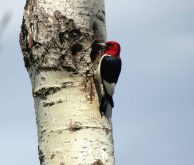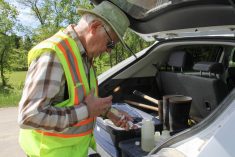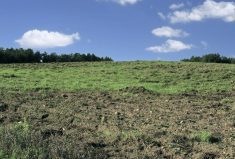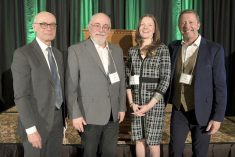Manitoba farmers heading out to plant this spring can thank the likes of R.T. Riley for the fact that they have fields to work instead of swamps.
Riley, best known today as one of the founders of the Great West Life Assurance company (now Canada Life), was the son of a prominent British businessman who landed in Manitoba in 1881 to resuscitate the underperforming Manitoba Drainage Company.
It’s hard to imagine today what the landscape here would have looked like back when the European settlers first arrived; it’s equally difficult for modern-day farmers to envisage restoring some of its historical assets.
Read Also

Ag Days Gives Back 2026 focuses on fire response
Manitoba Ag Days charitable program, Ag Days Gives Back, returns for 2026 with a new wave of rural community support in Manitoba and southeast Saskatchewan
Some of the most prominent features of that landscape were vast wetlands, stretching for mile upon mile and the first order of business was to drain them. Some did it in a small way. Others undertook megaprojects.
University of Manitoba wetland ecologist and history buff Gordon Goldsborough (a frequent contributor to these pages) told the Co-operator that the company’s major project was to drain the Big Grass Marsh, on the western shore of Lake Manitoba, north of Gladstone.
“Riley came to Manitoba to drain wetlands,” Goldsborough said.
That massive wetland covered more than 100,000 acres. By the early 1900s it had been all but emptied and made into farms. There was a central core that resisted drainage, especially in wet cycles, but the marsh that had stood there since the end of the last ice age was almost eradicated.
Why it matters: Reimagining our culture of drainage will be pivotal to capitalizing on the sustainability benefits of wetlands.
By the 1930s, that drainage was being reconsidered, in the height of the Depression as much of the North American plains suffered through drought and dust bowl, including the Big Grass Marsh area. Local groups and wildlife organizations undertook to replenish and revitalize the wetland, culminating in what became Ducks Unlimited’s first Canadian project, begun in 1938.
The resulting wetland never regained its pre-1900 level, but it did result in an area of roughly 12,000 acres being returned to its natural state.
Sign of the times
The draining of those vast wetlands wasn’t unique to the Big Grassy Marsh. St. Andrews Bog suffered a similar fate.

That wetland covered the area from what’s present-day north Winnipeg up to Teulon. In total it covered more than 116,000 acres, or 181 square miles. Today its remnant is the present-day Oak Hammock Marsh, which was similarly restored during the 1970s with 22 kilometres of earthen dikes and covers roughly 9,000 acres (or 14 square miles).
And early Manitoba’s penchant for draining didn’t stop there. Thousands of drainage projects, large and small, vastly altered the natural landscape. Why that happened is down to the desires of the early farmers to carve out productive farms and prosperous futures.
“Those early settlers, when they saw a wetland, they saw a net loss,” Goldsborough said. “To them, a wetland was a potential farm, covered by water.”
Tim Sopuck, the former CEO of Manitoba Habitat Heritage Corporation (MHHC) echoed that sentiment, saying Manitoba’s pioneer farm families were doing everything they could to succeed in a challenging new environment.
“Why they chose to drain, back then, is perfectly understandable,” Sopuck told the Co-operator.
But the part of the equation that was missing was failing to understand, as a society, what wetlands do for us all.
Sometimes that value is economic — retaining water and preventing drought and providing irrigation opportunities when drought does hit, for example. Sometimes that value is economic but hard to quantify — slowing and holding enough water that the province doesn’t have to deepen the floodway yet again around Winnipeg, for example.
And other times the value is real, if not immediately economically measurable. Greater biodiversity, for example. And over time, those benefits can generate other economic activity, Goldsborough said.
“What’s the economic value of a duck?” he asked. “It can be hard to quantify that. But what about when someone comes to hunt that duck? Presumably they’re putting gas in their vehicle, buying supplies, maybe staying in a motel. Those are very real and measurable economic benefits.”

Rebuilding and regenerating
Bringing wetlands back to life isn’t simple, and it can, at times, be controversial.
Big Grass Marsh provides yet another example of this. Periodically that area has been the scene of some conflict over managing water levels, most recently in 2015.
That’s when someone, likely a frustrated local landowner, dug an illicit drainage trench to lower the water level in the wetland. Then Westlake-Gladstone mayor Dave Single told media at the time he was hearing complaints the water level was too high, it was flooding nearby farmland, and that DU seemingly wasn’t willing to lower the water level when approached.
“The agreement we have with them prescribes an area that should be flooded by their structure. What’s being flooded now is way outside that prescribed area. The agreement also says that if it goes outside the prescribed area, they’re supposed to do something about it, and they refuse to do that,” Single was quoted as saying.
DUC, however, said it had found no evidence of this, noting in an article on its website from the time that the control structure was designed to let excess water spill into Big Grass River, rather than onto surrounding land. It also said a wet cycle at the time was the more likely cause of overland flooding.
“Decades of wetland drainage in the watershed is also compounding the problem: water drained from one property simply moves to the next, and then the next, eventually ending up on low-lying property and areas like Big Grass Marsh,” the article reads.

Sopuck says the importance of building good relationships with local landowners is key to preventing problems from arising. However, he noted, the local flooding issues can become intense, and views get hardened.
“To the extent possible, it’s about building trust,” Sopuck said. “You don’t want to come in and start telling people what they should be doing. You want to work with them.”
It’s only by building that relationship, and showing the value of the wetlands, and that they can be restored in a way that works for the landowner, that progress will be made, he said.
Goldsborough agreed and noted that he’s seen a lot more interest in wetlands, and greater understanding of their value, from landowners in recent years. He also said that it’s important for society as a whole to be willing to pay for what it wants landowners to deliver, citing a growing recognition of the value of ‘environmental goods and services.’
“We can’t just say to farmers and landowners, ‘here’s what we want you to do for us,’” Goldsborough said. “We need to be willing, as citizens and taxpayers, to pay them for those things that benefit us all.”
Paying the bill
When it comes to having a viable model for funding these projects, so farmers and landowners aren’t out of pocket, Manitoba is in an enviable position.
There are three funding streams — the Conservation Trust, the Manitoba Grow Trust and the Wetlands Grow Trust — that were established between 2018 and 2020. It gives conservation work, like wetlands restoration, a financial foundation that isn’t found in other provinces, Sopuck said.
MHHC, the organization he until recently headed, administers the grants for projects funded by the $202-million endowments, which are held and invested by The Winnipeg Foundation. This year the trusts generated $10.36 million for projects.
Sopuck says many organizations throughout the province have benefited from grants from the trusts, especially Manitoba Watershed Districts (the former conservation districts, reorganized under watershed lines).
“Many of them have told me this funding really lets them increase their activities,” Sopuck said. “They know that there’s a steady stream of funding available for their projects, and that’s really let them do more.”
Goldsborough echoed the importance of the Manitoba funding model, saying it’s already resulting in more wetland restoration projects. He says he expects the effect of these projects to be cumulative over time, and to revolve around the model of local organizations like watersheds partnering with local groups to make incremental improvements over time.
“Certainly nobody is saying we should go back to how it was in 1870,” Goldsborough said. “But there is a lot of room here to fund projects that can make a real difference and benefit the local landowners too.”
Sopuck noted that draining wetlands took place over generations, so nobody should expect quick fixes.
“We will make a difference, but it’s not going to happen tomorrow,” he said. “It’ll happen over decades too.”
















